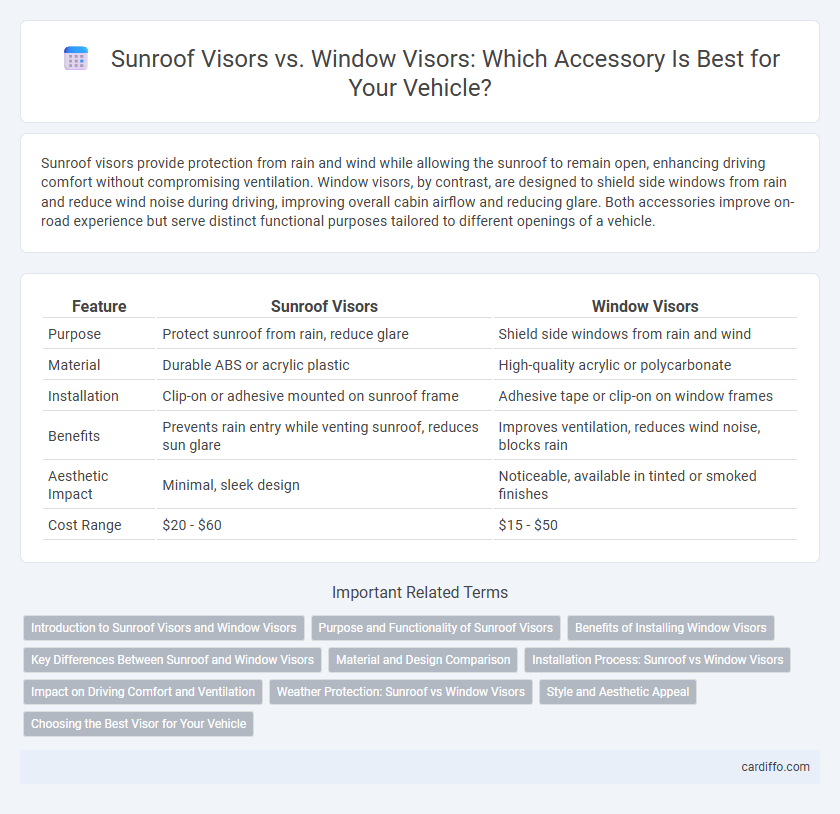Sunroof visors provide protection from rain and wind while allowing the sunroof to remain open, enhancing driving comfort without compromising ventilation. Window visors, by contrast, are designed to shield side windows from rain and reduce wind noise during driving, improving overall cabin airflow and reducing glare. Both accessories improve on-road experience but serve distinct functional purposes tailored to different openings of a vehicle.
Table of Comparison
| Feature | Sunroof Visors | Window Visors |
|---|---|---|
| Purpose | Protect sunroof from rain, reduce glare | Shield side windows from rain and wind |
| Material | Durable ABS or acrylic plastic | High-quality acrylic or polycarbonate |
| Installation | Clip-on or adhesive mounted on sunroof frame | Adhesive tape or clip-on on window frames |
| Benefits | Prevents rain entry while venting sunroof, reduces sun glare | Improves ventilation, reduces wind noise, blocks rain |
| Aesthetic Impact | Minimal, sleek design | Noticeable, available in tinted or smoked finishes |
| Cost Range | $20 - $60 | $15 - $50 |
Introduction to Sunroof Visors and Window Visors
Sunroof visors enhance vehicle ventilation by allowing sunlight and fresh air while minimizing wind noise and rain entry through the sunroof opening. Window visors, also known as rain guards or vent visors, fit over side windows to permit air circulation while protecting from rain and reducing wind turbulence. Both accessories improve driving comfort by managing airflow and preventing weather elements from entering the vehicle interior.
Purpose and Functionality of Sunroof Visors
Sunroof visors are designed to enhance ventilation by allowing fresh air to circulate while protecting the interior from rain, wind, and excessive sunlight. These visors reduce wind noise and turbulence when driving with the sunroof open, improving overall comfort. Unlike window visors, sunroof visors specifically target sunroof openings, preventing debris and insects from entering without obstructing the airflow.
Benefits of Installing Window Visors
Window visors enhance vehicle comfort by allowing fresh air circulation while protecting interiors from rain and wind noise, improving overall driving experience. They reduce glare and sun exposure, minimizing UV damage to upholstery and enhancing passenger comfort. Additionally, window visors contribute to better aerodynamics, which can slightly improve fuel efficiency and reduce wind turbulence during travel.
Key Differences Between Sunroof and Window Visors
Sunroof visors are specifically designed to fit over the sunroof opening, allowing ventilation without letting rain or debris enter the vehicle, while window visors are installed above side windows to reduce wind noise and rain intrusion during window operation. Sunroof visors typically have a larger, more curved shape to match the roof contour, whereas window visors are slimmer and follow the window frame's profile. Both accessories improve cabin comfort and airflow but serve distinct functions based on their installation points and design.
Material and Design Comparison
Sunroof visors are typically crafted from lightweight, durable acrylic or polycarbonate materials designed to withstand sun exposure and reduce glare, featuring a curved design that seamlessly fits over the sunroof frame to deflect rain and wind. Window visors commonly use tinted or smoked acrylic, allowing for ventilation while minimizing rain entry, with a streamlined shape that adheres above the side windows to provide protection without obstructing the view. Both accessories prioritize aerodynamics and weather resistance, but sunroof visors emphasize enhanced glare reduction and rain diversion for overhead openings, whereas window visors focus on maintaining airflow and side window visibility.
Installation Process: Sunroof vs Window Visors
Sunroof visors typically require precise alignment and secure attachment around the sunroof opening, often involving adhesive tapes or clips designed for curved surfaces. Window visors generally have a simpler installation process, using strong double-sided tape or rain guards that fit along the top edge of car windows. Both types demand clean surfaces and careful positioning to ensure a secure fit and prevent water leakage.
Impact on Driving Comfort and Ventilation
Sunroof visors enhance driving comfort by reducing wind noise and glare while allowing fresh air circulation without fully opening the sunroof, improving ventilation. Window visors enable drivers to keep side windows slightly open during rain or hot weather, preventing fogging and promoting airflow inside the vehicle. Both accessories contribute to a more comfortable cabin environment by balancing ventilation and protection from external elements.
Weather Protection: Sunroof vs Window Visors
Sunroof visors provide targeted protection by preventing rain, snow, and wind from entering through the sunroof while allowing fresh air circulation. Window visors, designed for side windows, shield the interior from rain and wind, reducing fogging and enhancing ventilation without fully opening the windows. Both accessories improve weather resistance but cater to different vehicle openings, enhancing overall comfort and driving experience.
Style and Aesthetic Appeal
Sunroof visors enhance a vehicle's exterior by seamlessly integrating with roof lines, offering a sleek and modern look that complements the car's overall design. Window visors emphasize both function and style by subtly accentuating the side profile while providing a sporty, streamlined appearance. Choosing between sunroof and window visors depends on desired aesthetic impact, with sunroof visors delivering a minimalist elegance and window visors creating dynamic visual interest.
Choosing the Best Visor for Your Vehicle
Sunroof visors are designed specifically to fit over the sunroof, preventing rain and debris from entering while allowing ventilation, making them ideal for vehicles frequently exposed to varying weather conditions. Window visors, on the other hand, are mounted above side windows and enhance airflow by reducing wind noise and glare while driving with windows slightly open. When choosing the best visor for your vehicle, consider the specific window type, weather protection needs, and compatibility with your car's design to ensure optimal functionality and comfort.
Sunroof visors vs window visors Infographic

 cardiffo.com
cardiffo.com